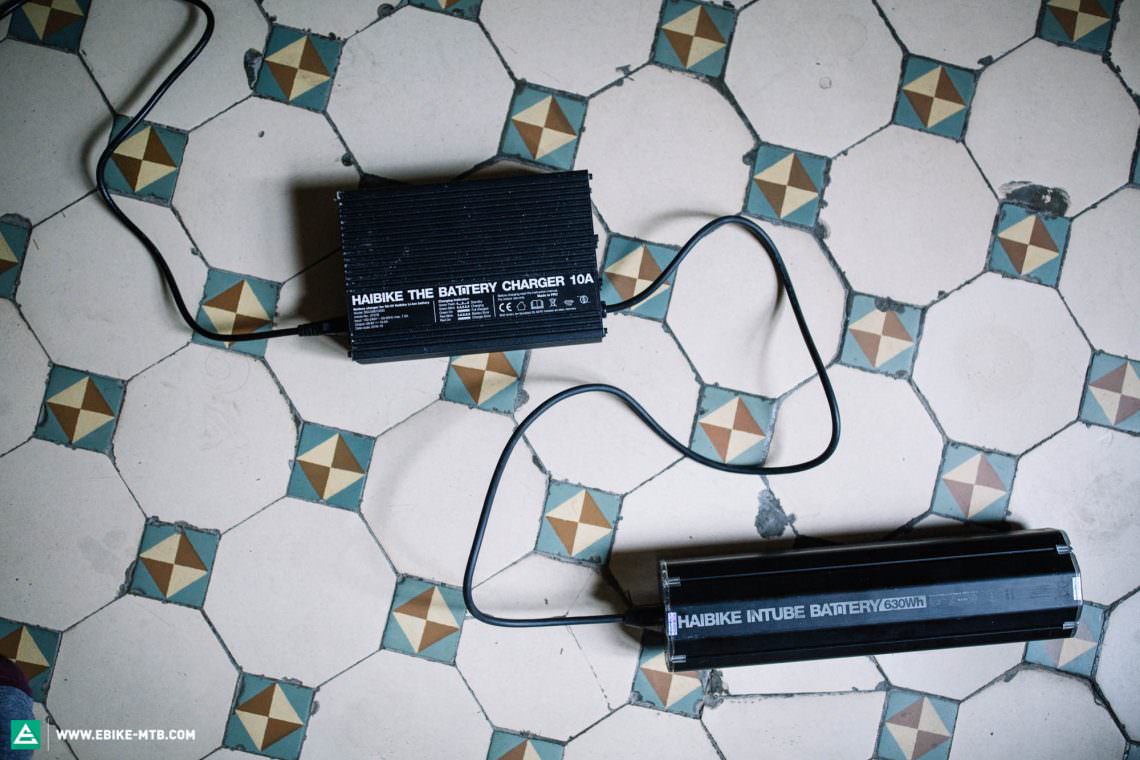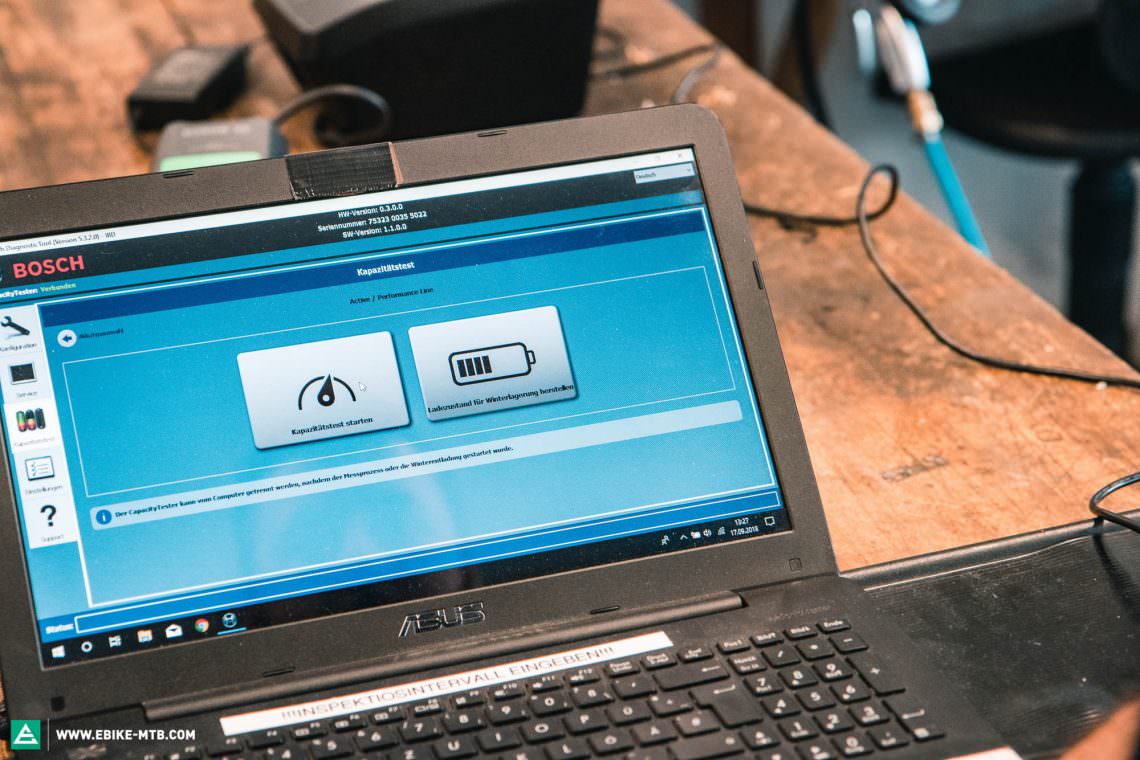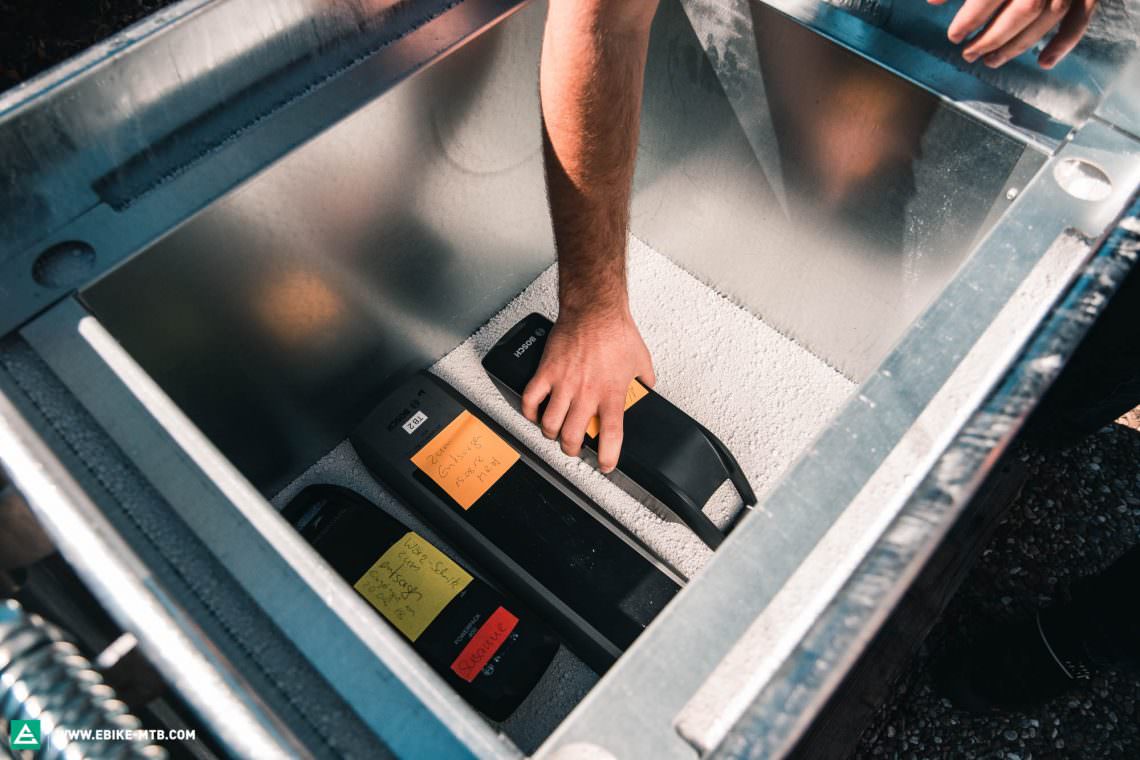Hardly a day goes by without news on battery technology for e-mobility. Lithium-ion batteries are still the battery of choice for mobile devices, including eMTBs. Read on to find out why this is the case and why battery chemistry is top secret. you don’t need a chemistry degree for a basic understanding of how the battery on your ebike works

Electric bikes allow us to get to work without the stress of traffic jams or being covered in sweat. They take the load off couriers, serve as a healthy, joint-friendly means of transport and they take us to trails that we could hardly have managed with leg power alone. The market is expanding rapidly and we’ve come take e-support for granted. However, the seemingly simple thing that makes our lives so much easier is actually quite complex. That’s why we’re going to give you a little insight into your eMTB’s power plant: the battery.
The start of the boom
When lithium-ion batteries were introduced to the market in the early 1990s, they marked the beginning of a new era. While many manufacturers initially still relied on nickel-metal hydride batteries, powerful lithium-ion batteries had overtaken the industry at the beginning of the 21st century. The benefits? First of all, it’s worth mentioning the lower weight, which has proven itself particularly useful when used in portable devices such as notebooks, smartphones, cordless drills and ultimately also the electric car and bicycle. Above all, however, lithium-ion batteries have a high energy density, capable of storing more energy at a relatively low weight. The three scientists who laid the basis for this revolutionary energy storage technology – Stanley Whittingham, Akira Yoshino and John Goodenough – were awarded the Nobel Prize in Chemistry last October. But that isn’t good enough for Goodenough. The oldest Nobel Prize winner is looking to start the next revolution in stationary energy storage using solid-state batteries, which will be more durable, able to withstand more charging cycles and be non-flammable. Solid-state batteries aren’t yet relevant for use in small, mobile ebike batteries and probably won’t be in the near future.
The construction of a battery – and the secret files of battery chemistry
When we talk about energy storage devices we generally refer to them as batteries. In contrast to non-rechargeable batteries (primary batteries), rechargeable (secondary) batteries can be charged and discharged several times. At the heart of the battery are several electrochemical cells, so called galvanic elements, connected in series. Because individual cells produce a relatively low voltage and capacity, many have to be connected together to match the requirements of something like an eMTB battery. In turn, the capacity of these cells is a huge factor in battery research as it plays a major role in the range and performance of electrically powered vehicles. While capacity can be increased with more cells, increasing the size and weight of the battery, it is also influenced by the material combination of the electrodes and layers in the cells. Finding the optimal combination and mix of materials is very tricky: the electrode material determines the voltage output during normal operation and determines the electrical current nominal output voltage. The storable energy in turn depends on the nature of the materials used. In addition, a battery must also be able to survive many charging cycles, which is why different materials are used for the stabilising layers.
The maximum permitted charging or discharging current also varies depending on the battery design, as does its temperature sensitivity. If you change a component of the electrode to increase the thermal stability, this in turn can have a negative influence on the capacity. Whatever the cocktail ultimately contains, the general rule is that the more uniform the chemical composition of the battery, the higher the performance and lifetime. After all, the best cocktails only have a few ingredients that harmonise well in combination. With all these variables, it’s not surprising that the material mix used by the manufacturers is usually a closely guarded secret.

Whatever the cocktail ultimately contains, the general rule is that the more uniform the chemical composition of the battery, the higher its performance and lifetime.
With a rechargeable battery, energy is stored in a reversible electrochemical processes. The efficiency of this process is high (over 90%), meaning that almost all the energy stored can be recovered when needed. When discharging (e.g. when using your ebike), the energy stored in chemical form is converted into electrical energy via an electrochemical reaction. This potential difference of the battery (voltage) cause current to flow when the circuit is closed, driving the motor of your eMTB.
To allow the cell to be connected in a circuit, there is a special metal layer, the current collector, on each side. The electrodes of the battery are connected to these two conductors: in the case of the aluminium layer, this can be a layer made of lithium metal oxide (e.g. lithium cobalt dioxide, LiCoO2), which is the positive pole (cathode). On the anode side, copper is bonded to a layer of pure graphite electrode a natural form of carbon with a high energy density. To avoid a short circuit, the anode and cathode are separated by a separating layer (separator).
The cell is filled with an extremely pure and water-free electrolyte solution that contains an ion-conducting lithium salt.
The majority of the batteries on the market today are lithium cobalt dioxide batteries, including those on ebikes. Lithium only makes up 1–1.5% of the battery material used, but it is the crucial player in the system. All reactive components, the negative and positive electrodes as well as the electrolyte solution, contain lithium, as single positively charged ions (Li+) that transport an electrical charge between the negative and positive electrodes.

The charging and discharging processes
When you use the motor on your ebike, the battery gradually uses its charge. In a charged state, the graphite anode “holds” onto excess lithium ions. When the circuit is closed a chemical reaction creates electrons that flow through the circuit, creating a current. To equalise the change in charge caused by the negative electrons, the positive lithium ions also migrate back to the cathode. This is where the electrolyte is key, allowing the lithium ions to move internally in the battery but stopping the electrons, meaning that they have to flow through the circuit instead. The whole process is driven by the difference in potential between anode and cathode. When the circuit is closed, the reaction can occur, when it is open it stops.
It’s like a bar where the chemistry nerd tries to chat up the energetic party girl. The moment someone starts their motor outside, the electron girl gets up and leaves behind her group on the anode side of the bar. The nerd feels sad that he’s been left alone, but notices that somehow the electron girl has ended up on the other side of the bar. Being sociable, she’s moved on a circuit through the whole space before ending up on the other side. Ever hopeful the nerd flows as a charge-balancing Li+ ion through the counter to the other side of the bar and arrives on the cathode side. Usually, the counter functions as a barrier between the two sides but there is a cool back door most people don’t know about. But the nerd does (he’s smart after all). The barrier is made of a microporous plastic, almost like a GORE-TEXmembrane, only permeable by the nerdy Li+ types. He slips through to try and meet up with the electron girl again on the other side. The process isn’t an isolated incident. The bar has a surprising number of electron girls and Li+ nerds, who keep going through the same process. The cathode side of the bar is very sociable and welcoming, with everyone flowing away from the anode side until they’re all gone and the battery is empty. In the spirit of equality, we would like to make clear at this point that there are at least as many electron guys at the bar!
When we recharge the battery, a voltage is applied from the outside, which creates an excess of electrons at the anode. The lithium ions now flow in the opposite direction from the cathode to the anode and are stored in the anode.
The electrolyte solution serves as the transport medium for the positively charged lithium ions. It must be pure and water-free as lithium is very reactive with water. This is one of the reasons why you should use high-quality original batteries instead of those from unbranded manufacturers. Currently, there is a lot of interest in the composition of the electrolyte, with a lot of research into replacing the current organic electrolyte with an inorganic one in order to increase energy density and ultimately the range. It’s a tricky thing: the electrolyte has to be capable of handling a current of around four volts. Since watery electrolytes form reactive gases at this voltage, resulting in a reduced lifespan of the battery, organic solvents (mixed with conductive salts) are still the medium of choice. It’s also key for the electrolyte to form a stable layer on the graphite anode when the battery is first charged. This acts as a protective coat, preventing the organic solvent from further decomposing the anode during further charging cycles. But there is more to the perfect cocktail: additives are used to reduce the viscosity, allowing the ions to pass through more easily and there are other chemical components besides, like ones to reduce flammability.
All of these factors emphasise the importance of a pure liquid to avoid disturbances during the charging and discharging cycles. The separator also has to be of high quality to avoid a short circuit. It’s obvious: the quality of the cell components is extremely important, which is why a reputable manufacturer is crucial.

Fire hazard: what about the flammability of lithium-ion batteries?
Lithium is a naturally reactive and self-flammable light metal. Depending on the type of battery, the temperature limit can be between 150° C and 250° C. If this limit is exceeded, the lithium reacts with other components of the battery cell, generating even more heat, creating a runaway thermal reaction. At around 300° C, the liquid electrolyte will start burning. To prevent this from happening, lithium-ion batteries have an integrated electronic circuit, the so-called battery management system. It acts as a control unit and ensures that all the cells experience equal loads. After all, good management is supposed to ensure a healthy and happy long-term working environment.
Even though battery manufacturers guarantee the quality of their product and the components used, we recommend following a few general guideline nonetheless:
- Only use batteries and chargers that are certified to a certain safety standard (CE standard) and always use the right charger for the battery, as this ensures proper shutdown.
- Do not expose the battery to extreme temperatures, the ideal temperature range is between 10° C–30° C.
- Avoid deep discharge: if you don’t use your ebike for a long time you should remove the battery from the bike and store it with at half charge at a temperature of about 15° C. If the battery isn’t removable, you will have to store the bike accordingly. (If the battery is empty and you recharge it after it’s been stored below 0° C for a long time, the cell can expand, which can lead to deflagration.)
- If the battery was kept in a cold environment for a long time, it should first be brought slowly back to room temperature before being recharged (remove the battery or take the bike to a warmer room). Do not leave the battery unattended when you first recharge it.
- Do not charge the battery on flammable objects (such as wooden boxes or the like) or near flammable substances (gasoline).
- Do not use a battery if it’s been damaged. Take it to your dealer and replace it only with the correct original model. Not every battery management system can communicate with every motor and if it isn’t the correct battery, this could lead to complications.
Why lithium-ion batteries are the best choice for e-(mountain)bikes
Currently, there is a race taking place to find the best solution for electric mobility. There is a lot going on in the automotive and industrial sectors, especially in the area of stationary energy storage. Australian scientists have recently made advances with lithium-sulphur batteries, but the technology is still in its infancy. You’ll be seeing them crop up in situations where weight is more important than size, such as aeronautics, because although their energy density is much higher than lithium-ion batteries, giving you more energy for the same weight, they are also quite a bit bulkier. That means we’re unlikely to see lithium-sulphur batteries feature in ebike tech anytime soon. Lithium-ion batteries continue to be the standard for small, mobile and rechargeable energy storage devices on electric bikes. Their advantages are undisputed.
With lithium-ion batteries, the energy density and capacity are high due to the high cell voltage and the resulting range is entirely sufficient. Who wants to ride 1,000 km a day anyway? They also score for their low capacity loss and they can be recharged countless times. In addition, lithium-ion batteries offer a long shelf life due to minimal self-discharge and a relatively wide temperature range for storage and operation. They are also comparatively cheap to manufacture. Lithium-ion batteries are being optimised and are becoming more and more powerful without adding much weight or bulk. So what’s the deciding factor here? You can guess the answer: it’s the chemical components and their influence on the charging process, which brings us back to those top secret files.

We don’t know exactly how some manufacturers save weight or charge the battery more quickly, but a closer look at different ebike batteries on the market reveals some interesting numbers. The integrated 500 Wh Bosch PowerTube battery weighs around 200 g less than the integrated 504 Wh Shimano STEPS BT-E8020. Likewise, the external 500 Wh Bosch PowerPack has a weight advantage of 100 g compared to the 504 Wh Shimano STEPS BT-E8010 battery. It’s just as interesting to look at charging times. While Bosch’s Fast Charger achieves a full charge in three hours, the Shimano STEPS EC-E6000 quick charger takes four hours. TQ are one step ahead and manage to charge a 630 Wh battery to 80% capacity in one hour. The Bosch Fast Charger reaches only 40% of a 500 Wh battery in one hour. However, these differences could be just as much due to chemistry as they could to how the batteries are ultimately packaged or the charging currents the manufacturers allow.
A lot of progress has also been made with regards to battery recycling. Some energy providers and startups are aiming for a recycling rate that exceeds the 50% of recyclable elements within the battery (currently) prescribed by the EU. There are methods that have even increased this quota to over 80%. The fact that mobility via (e-)bikes is being supported more than ever around the world is only logical. That’s not only to reduce CO2 emissions, but also because the smaller batteries of an ebike are arguably less resource hungry, produce less CO2, are cheaper and can be run more efficiently than the huge batteries needed to power an electric car. Reading about all these chemical cocktails makes you want to treat yourself to a drink, have a cold post-ride beer with your friends. You’ll be 100% recharged and refreshed.
To read more about eMTBs, the latest tech and other facts and figures, or if you’re looking for a buyer’s guide, check out the following articles:
- Supercharger – when will we finally see proper eMTB quick chargers?
- The best eMTB motor you can buy
- An overview of the most important eMTB battery systems
Did you enjoy this article? If so, we would be stoked if you decide to support us with a monthly contribution. By becoming a supporter of E-MOUNTAINBIKE, you will help secure a sustainable future for high-quality cycling journalism. Click here to learn more.
Words: Simone Giesler Photos: E-MOUNTAINBIKE team









